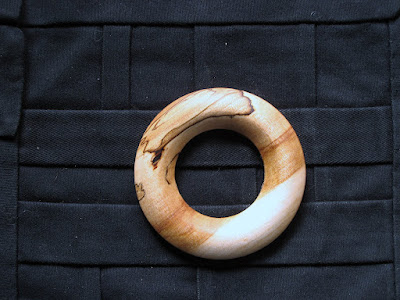I'm a wood worker and a zen practitioner. I make wooden rakusu rings. Below are the images of rings I've made and are in service around the country. This is a sampling, the currently available rings and the one I might make for you are different because wood color and grain pattern, even in the same species of wood, are varied. Click on the image for a higher resolution view.
If you see any here you like, email at will@kestrelcreek.com. Please enclose details about your practice, the group and linage you practice in, when and with whom you will be taking jukai. Anything you'd be willing to share.
Woods I used in the past.
If you see any here you like, email at will@kestrelcreek.com. Please enclose details about your practice, the group and linage you practice in, when and with whom you will be taking jukai. Anything you'd be willing to share.
Woods I used in the past.
- Birds Eye Maple
- Pacific Yew
- Box Elder
- Walnut
- Madrone
- Ash
- Lacewood
- Apple
- Spalted Birch
Precept guide, rakusu pattern and photos of a completed rakusu. http://palousezen.org/jukai.html
Spalted River Birch (Spalting varied a lot, this one is medium)
 |
| From Available Rakusu Rings |
Apple
 |
| From Available Rakusu Rings |
Birds Eye Maple with natural dark streaks.
 |
| From Available Rakusu Rings |
Box Elder with a small bark inclusion.
 |
| From Available Rakusu Rings |
Birds Eye Maple with natural dark streak.
 |
| From Available Rakusu Rings |
Birds Eye Maple
 |
| From Available Rakusu Rings |
Box Elder Burl
 |
| From Available Rakusu Rings |
Birds Eye Maple
 |
| From Available Rakusu Rings |
Box Elder with a natural reddish streak.
 |
| From Available Rakusu Rings |
Walnut One
 |
| From Available Rakusu Rings |
Madrone Burl
 |
| From Available Rakusu Rings |
Walnut Two
 |
| From Available Rakusu Rings |
Box Elder Burl One
 |
| From Available Rakusu Rings |
Ash One
 |
| From Available Rakusu Rings |
Ash Two
 |
| From Available Rakusu Rings |
Box Elder Burl Two
 |
| From Available Rakusu Rings |
Lace Wood One
 |
| From Available Rakusu Rings |
Lace Wood Two
 |
| From Available Rakusu Rings |





.jpg)




